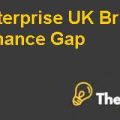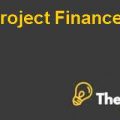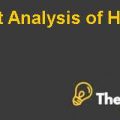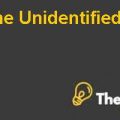
Q1. How attractive is the AccuFlow deal, i.e., should HPC want to finance it?
The CEO of AccuFlow at the end of 1997 was motivated to move into second buyout, the idea was well supported by the rest of the management as this management's buyout will give the management majority of the holding in the company.
The current majority holders of the company are two venture capitalist firms who had provided the funds for the first buyout, which were very much happy with their investment and were too thinking of a method to realize their profits made in the company. They believed an IPO should be the way to go through which the management and themselves could receive the maximum return for their stake in the company, but they were also open to discussion for a second buyout giving the management the holding stake.
With gross sales and earnings before tax both growing at an average rate of 15% combined with the commitment that the management has in the company along with the great success of the first buyout makes this a must have investment.
When the management of AccuFlow and the venture capitalists meet with the partners of HPC regarding the discussion of the mezzanine financing, the partners walked out very satisfied and created a more flexible lending terms for AccuFlow in just 7 days which shows the confidence of HPC in AccuFlow, considering the fact with the current economic conditions there will be very few companies that would come for financing with such positive cash flows and committed management which reduces the risk of default for the lending company very severely, HPC should most definitely finance this operation.
Q2. How attractive is the transaction? How much money does HPC have to provide? What coupon should HPC charge? What fraction of the equity should HPC ask for? What IRR will they expect to earn?
The attractiveness of this transaction is based on the structure offered by HPC, since the structure offered by HPC is more flexible in aspects of the repayment maturity period, penalty for early repayment, time period after which early repayment can be made, but most important of all the expectation that the HPC will be inspired to provide a higher amount of debt than other lenders makes this a very attractive transaction.
Considering the fact the $25million offered to AccuFlow would lead to merrily $103.4 million to the venture capitalist is not considered acceptable to them, especially when the company has a very high growth potential, the introduction of HPC was made by the venture capitalist with the expectations a higher amount will be financed through them.
If HPC loans an amount of $35million with a coupon rate of 14%, which has a breakup as 10% cash return and 4% payment in kind, the payment in kind will lead to compounding of debt upon which the 10% cash charge will be made the total compounded loan at the maturity date minus the initial loaned amount will give the value of payment in kind. 11.5% being the assumed market rate that is calculated as 5.5% market risk assumed plus 6% rate of long term risk free bonds, through consideration of above values the Net present value of HPC’s investment of $35million stands at $4millionwhich would give them an IRR of 14%, which is more than acceptable for this transaction, this working is based on the assumption that equal amount of payments will be made in each 7 years rather than early payments after year 2.
Considering the fact that the economy is performing that well with great risk of default lurking over each investment made HRC should take the safe road and ask AccuFlow to invest 15% of equity minimum to this transaction to increase the confidence of HPC.
Q3. What do you think the actual deal will look like relative to the starting point?
The comparison among the starting point deal and the deal offered by HPC clearly shows that HPC is a more favorable option.
The starting point deal has a maturity date of 10 years, whereas the HPC provides a 7 year deal making the interest payments will only be made for 7 years rather than 10, the10 year maturity date will distribute the total loan more evenly but this will make AccuFlow pay more interest.
The starting point deal if offering merrily $25million which is not acceptable to the venture capitalist as this will limit their return to only $103million which they believe is very small compared to the large growth the company is experiencing, whereas HPC is willing to give $35 million to AccuFlow which is more acceptable to the VC’s as they are the ones who introduced them in the first place.
The stand point deal is charging 15% coupon...............
This is just a sample partial case solution. Please place the order on the website to order your own originally done case solution.













